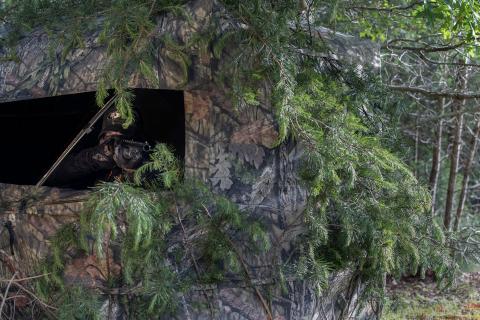D.J. Randolph | Mossy Oak ProStaff
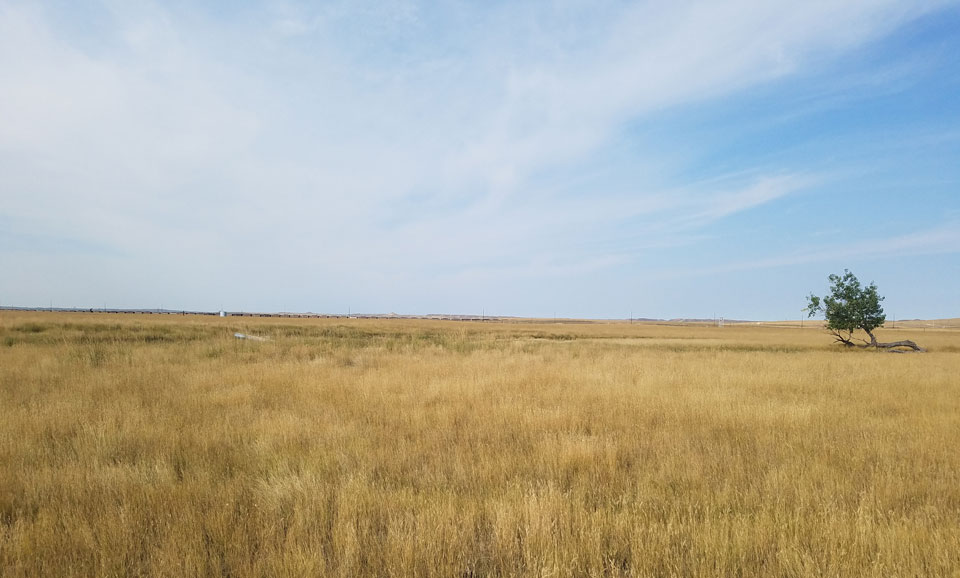
The fascinating thing about mule deer is that they can be found from above the tree line in the highest part of the Rockies to the hot barren deserts of the Southwest. Their habits vary with the terrain, cover and food sources in their given environment. We have found them to be an interesting bowhunting challenge on the high plains of central Wyoming. This area is mostly open plains intermixed with hills and buttes. The region is primarily ranch land that is crisscrossed with oil and gas development. The primary vegetation on this harsh landscape varies from sage brush, to prairie grass, to cactus. Trees are few and far between. The first impression of this landscape is that it is great antelope country; they are everywhere, but not much else would live here. In fact, you can drive for hours, watching antelope in every field, and not see a mule deer. But, if you spend some time glassing in the early morning or late evening, you can discover areas that hold small populations of mule deer.
There are several challenges to hunting mulies in this area. The biggest challenge is they can be very hard to locate and they tend to cover large areas, so they can be unpredictable. Once you locate them, you have to get within bow range.
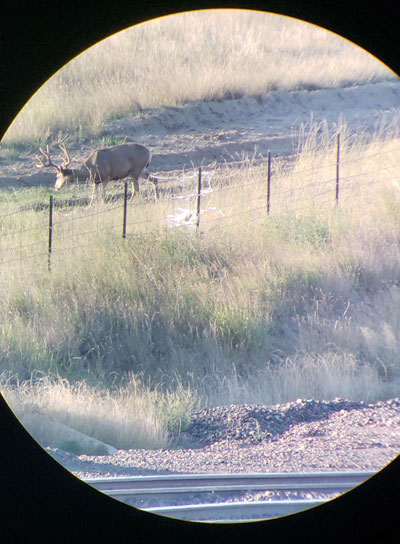 To find mulies in this area, you will need to spend a lot of time glassing and covering as much country as possible. This is best done by vehicle in early to mid-morning, moving from one vantage point to another. Once the sun starts getting high in the sky, these deer will be looking for a place to bed down. There are a lot of oil roads crisscrossing this country. It’s best to pick an area to glass and look it over from multiple vantage points. The thing you’ll discover about mule deer is they seem to appear and disappear just by taking a few steps. The reality is that the ground in this open country has small variances in terrain that can make mule deer seemingly appear and disappear with just a few steps. So, we try to glass the same area, multiple times, from multiple angles.
To find mulies in this area, you will need to spend a lot of time glassing and covering as much country as possible. This is best done by vehicle in early to mid-morning, moving from one vantage point to another. Once the sun starts getting high in the sky, these deer will be looking for a place to bed down. There are a lot of oil roads crisscrossing this country. It’s best to pick an area to glass and look it over from multiple vantage points. The thing you’ll discover about mule deer is they seem to appear and disappear just by taking a few steps. The reality is that the ground in this open country has small variances in terrain that can make mule deer seemingly appear and disappear with just a few steps. So, we try to glass the same area, multiple times, from multiple angles.
In early season, the temperature can range from 50-60 degrees at sunrise to 90-plus in the afternoon. The one predictable thing that these deer need once the temps start climbing is shade. If we haven’t found huntable deer by mid to late morning, we start focusing our glassing on shaded areas. You can find mulies in this open country bedded in the shade of large rocks, oil field equipment, hay bales, old farmsteads or even culverts. They like to bed in the shade backed up against a border. Another thing to keep in mind is that as the sun moves throughout the day, the deer will usually have to get up two to three times to move with the shade. This is where determination plays a huge role in this style of hunt. It’s easily to get discouraged but if you keep looking, you will eventually find deer.
Once you have found a buck that you want, a new challenge presents itself - how to get close enough for a bow kill. This may seem like an impossible task but those subtle variances in terrain that make the deer seem to appear and disappear can be used to your advantage. Unless they have been pressured, these deer are usually more tolerant of human behavior than deer in other areas. These mulies are used to seeing a lot of oilfield traffic and ranch work being done. They don’t want to leave their beds. One of the tricks to stalking them is to behave like you aren’t stalking them. By this I mean if you have to be out in the open, vary your approach. Move parallel to their location until you can get back into cover. Don’t spend long periods of time watching them. This will make them nervous. If you have to be seen, it’s best to act like you belong there and that you don’t even know that they are there. Many times they will watch you walk past them and let you get to better cover.
September 1, 2018 was opening day for archery. I was hunting with fellow Mossy Oak ProStaffer, Jeff Sekich and Travis Leier. Jeff had been scouting this ranch for a few weeks and saw some very good mule deer bucks. One place that he was consistently finding some good bucks bedded down was an old abandoned farmstead. The deer were bedding in the shade of an old house, barn and hay stack. We found three good bucks in this yard the afternoon before the season started. I decided that I would set up a ground blind in this yard and try to catch them coming in to bed. This is an unconventional approach to mule deer hunting but seemed promising. Jeff and Travis would spend the first day trying a spot-and-stalk approach.
My ground blind setup did not work out for me. As I said earlier, these deer cover a large area and are unpredictable. I sat in the blind for a full day on the first day and half a day on the second and did not see a deer. Travis and Jeff had a few failed stalks. We weren’t just struggling to find huntable bucks, we were struggling to find deer. The afternoon of the second day, we decided to go to another area of the ranch to try to locate some deer. This decision paid off very quickly.
It was a sunny afternoon and we were looking for deer bedded in the shade. It wasn’t long before Jeff spotted a buck bedded against some hay bales. The location was ideal because there were other bales that we could use for cover. We decided that Travis would be the shooter, and I would range for him. As we peaked around the bales, Travis found the bedded buck and I ranged him at 33 yards. We could only see antlers so we had to get him to stand. I looked around for a decent rock to throw in his direction but couldn’t find anything. What I did find was a large, dried out deer turd. (Hey, use what you got, right!?) It worked. The buck stood and Travis made a perfect shot. We recovered his buck about 70 yards away. It was Travis’s first mule deer and first velvet buck. After handshakes and pictures we had to get him cut up and on ice.
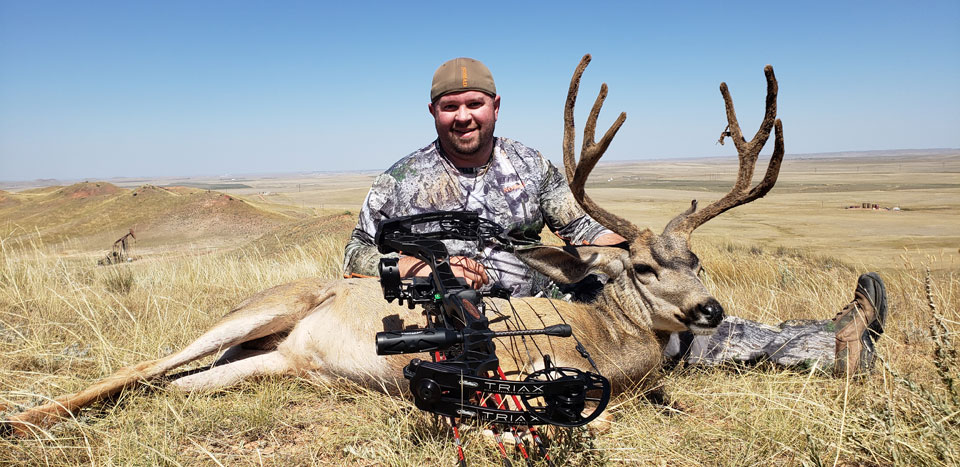
After we had Travis’s buck taken care of we had about four hours of prime time left to look for a buck for me. We spent the entire time moving from area to area with three of us glassing and could not find deer. It was a frustrating evening. Finally, with little light left, we found five bucks and two does. They were bedded in the shade of the railroad bed on property that we couldn’t hunt. When they got up to feed they went to the alfalfa fields further away on that property. That was the last place we wanted to see them go. We went to bed that evening with little hope and no definite plan for the next day.
On day three, Travis went on a scouting trip for another hunt. On our way to the ranch, Jeff and I tried to come up with a plan and stay positive, but it was obvious that we were both discouraged. There was heavy fog that morning, so we figured that would keep the deer on their feet longer throughout the morning. When we got to the ranch, we discovered that the thickening fog may not be to our advantage because we were having trouble seeing very far. We decided to just keep checking the places that Jeff had seen deer in the previous weeks and maybe we would get lucky. We checked the old farmstead and saw no activity there. As we were driving to the other side of that area Jeff said, “Is that deer out there by that tree?” My first response was, “No, just weeds.” But then I saw movement. We stopped and glassed for a few minutes.
When the fog cleared we started counting. One buck, two bucks, three, four, five...does…. It was the group of seven deer that had gone to the neighboring property the previous evening. Our discouragement disappeared immediately. We had found deer, but there was no decent approach on them. We decided to park about 400 yards away and just watch them, hoping they would move into a more huntable area. Keeping eyes on these deer was both thrilling and stressful. The fog would settle in and thicken, and we would lose sight of them for several minutes. But, every time the fog cleared a little, the deer were getting closer to us. We sat there for around an hour as the deer fed closer and closer to us. There was an “L” shaped windbreak fence about 70 yards from our position. To our disbelief, the deer fed to the backside of that windbreak. Jeff and I quickly hurried to the fence and found a gap to peak through. They were only about 70 yards away but the wind was wrong and they were starting to get nervous. As they slowly moved to the west I stepped to the corner and ranged the biggest buck at 66 yards. I am very comfortable at this range but must have rushed the shot, because I shot just under him. I couldn’t believe that I had blown my opportunity!
The deer weren’t very spooked. We watched them move into some tall brush about 400 yards away and hold up. They thought that they were hidden from us. I looked at Jeff and he said, “It’s worth a try.”
So we went back to the pickup, changed positions and made a stalk along the oil road. When I crossed the road, I heard Jeff whisper, “42 yards.” My last thought as I drew my bow was, “I hope he’s ranging the big one because that’s the one I’m shooting at.”
This time my arrow hit its mark. The buck was quartering away and my shot was behind the ribs. The buck went about 75 yards, and it was obvious that he was in trouble. We watched him bed down and decided to wait him out. We figured it was a liver shot so after one to two hours and he should be done.
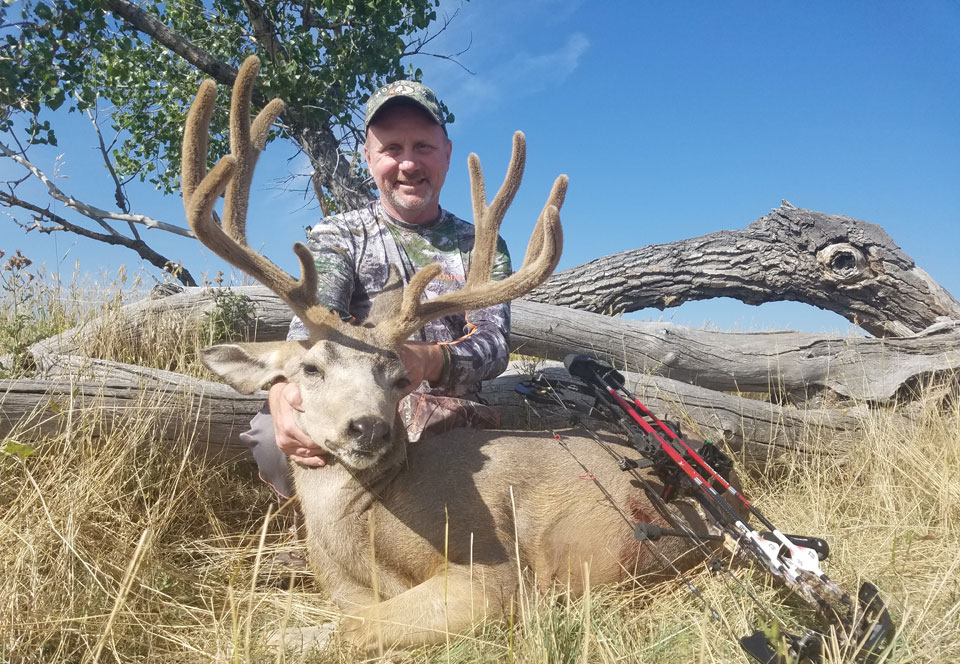
This is my 39th year bowhunting and I had never been more shook up. After about one hour the buck got up and started making his way to the north. We watched him bed again and then changed our vantage point. He was now bedded about 75 yards from the cottonwood tree where we first spotted the group. As we were waiting, I told Jeff that I wanted to take pictures by that cottonwood. A few minutes later the buck got up, stumbled over to the shade of the cottonwood tree, laid his head on a log and died. I couldn’t believe that I had gotten my velvet mulie!














